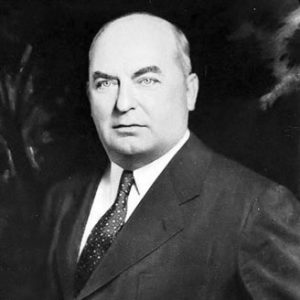S.C. Encyclopedia | Born in Blackwood, Spartanburg County, on November 21, 1878, Ibra Blackwood was the son of Charles Blackwood and Louvina Burns. After graduating from Wofford College in 1898, Blackwood read law and was admitted to the bar in 1902. That same year he was elected to the General Assembly, where he represented Spartanburg County for a single term in the House. In 1913 Blackwood became director of the South Carolina tax agency. Three years later he was elected solicitor of the Seventh Judicial Circuit. Blackwood made an unsuccessful bid for governor in 1926, losing to John G. Richards. He won four years later by narrowly defeating Olin D. Johnston in the Democratic primary.
In his 1931 inaugural address, Blackwood called for judicial reform. During the previous administration, controversy arose over the constitutionality of a massive $65 million highway measure that increased the state debt without a popular vote. Furthermore, some circuit judges had augmented their “expense money” in violation of the state constitution. Blackwood endorsed a strict interpretation of the constitution and a reduction of political pressures on the judiciary, but more important issues demanded the governor’s attention.
Blackwood entered office with the Great Depression well under way in South Carolina. The boll weevil, drought, and the collapse of tenant farming forced thousands of South Carolinians off the land and into towns or out of the state entirely. At first, Blackwood’s approach to the dire economic situation was conventional. He urged a balanced budget, which the state constitution mandated even in times of hardship. He reduced the salaries of state employees, who, by 1933, were being paid in scrip. In 1932 Blackwood joined with U.S. Senator James F. Byrnes to endorse Franklin D. Roosevelt for the presidency. Roosevelt’s victory brought an avalanche of New Deal assistance to South Carolina, including the Agricultural Adjustment Administration and the Civilian Conservation Corps, which brought relief to thousands of South Carolinians in the form of public works projects. One of the most lasting of these New Deal initiatives was the enormous Santee Cooper electrification project, which was secured through the extensive lobbying efforts of Governor Blackwood and Senator Byrnes.
Perhaps the greatest crisis of Blackwood’s administration occurred during the General Textile Strike of September 1934, when half of the state’s textile workforce went on strike to protest wage cuts and poor working conditions. When union picket lines went up around the state, Blackwood called out the National Guard and empowered “constables without compensation” to patrol mill villages. Blackwood justified his promanagement stance by claiming that South Carolina was “suffering a ruthless and insolent invasion” by groups engaged in “illegal and destructive enterprises.” On September 6 several of these “constables” fired on striking workers at Honea Path, killing seven and wounding fourteen. It was the worst violence of the strike. Blackwood left office the following year and resumed his law practice in Spartanburg, where he died of a heart attack on February 12, 1936.
— Excerpted from an entry by Joseph Edward Lee. This entry hasn’t been updated since 2006. To read more about this or 2,000 other entries about South Carolina, check out The South Carolina Encyclopedia, published in 2006 by USC Press. (Information used by permission.)




 We Can Do Better, South Carolina!
We Can Do Better, South Carolina!
























